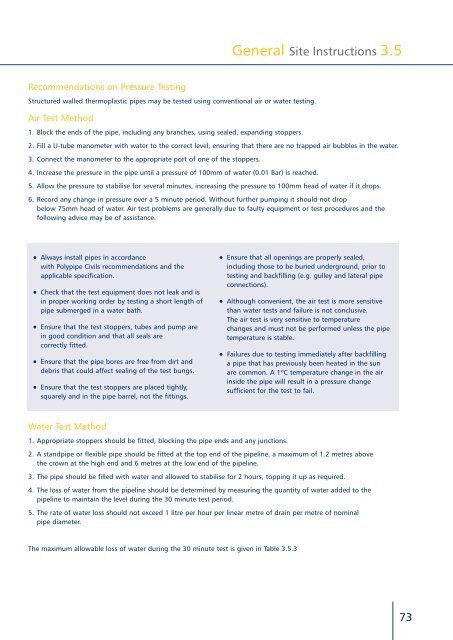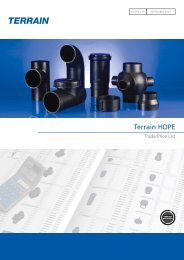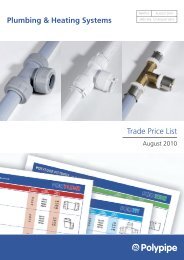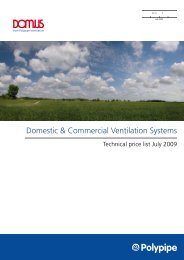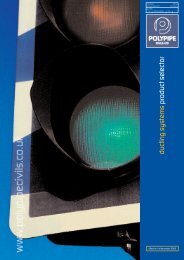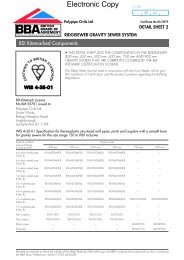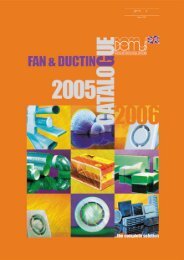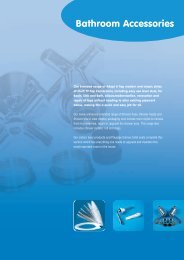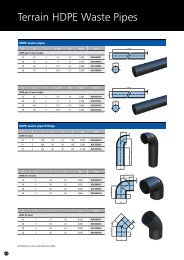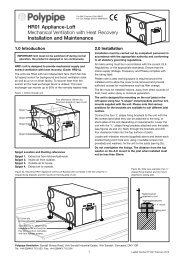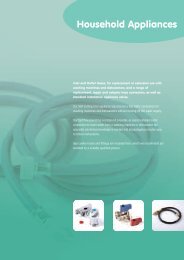advanced drainage system - Polypipe
advanced drainage system - Polypipe
advanced drainage system - Polypipe
Create successful ePaper yourself
Turn your PDF publications into a flip-book with our unique Google optimized e-Paper software.
General Site Instructions 3.5<br />
Recommendations on Pressure Testing<br />
Structured walled thermoplastic pipes may be tested using conventional air or water testing.<br />
Air Test Method<br />
1. Block the ends of the pipe, including any branches, using sealed, expanding stoppers.<br />
2. Fill a U-tube manometer with water to the correct level, ensuring that there are no trapped air bubbles in the water.<br />
3. Connect the manometer to the appropriate port of one of the stoppers.<br />
4. Increase the pressure in the pipe until a pressure of 100mm of water (0.01 Bar) is reached.<br />
5. Allow the pressure to stabilise for several minutes, increasing the pressure to 100mm head of water if it drops.<br />
6. Record any change in pressure over a 5 minute period. Without further pumping it should not drop<br />
below 75mm head of water. Air test problems are generally due to faulty equipment or test procedures and the<br />
following advice may be of assistance.<br />
• Always install pipes in accordance<br />
with <strong>Polypipe</strong> Civils recommendations and the<br />
applicable specification.<br />
• Check that the test equipment does not leak and is<br />
in proper working order by testing a short length of<br />
pipe submerged in a water bath.<br />
• Ensure that the test stoppers, tubes and pump are<br />
in good condition and that all seals are<br />
correctly fitted.<br />
• Ensure that the pipe bores are free from dirt and<br />
debris that could affect sealing of the test bungs.<br />
• Ensure that the test stoppers are placed tightly,<br />
squarely and in the pipe barrel, not the fittings.<br />
• Ensure that all openings are properly sealed,<br />
including those to be buried underground, prior to<br />
testing and backfilling (e.g. gulley and lateral pipe<br />
connections).<br />
• Although convenient, the air test is more sensitive<br />
than water tests and failure is not conclusive.<br />
The air test is very sensitive to temperature<br />
changes and must not be performed unless the pipe<br />
temperature is stable.<br />
• Failures due to testing immediately after backfilling<br />
a pipe that has previously been heated in the sun<br />
are common. A 1ºC temperature change in the air<br />
inside the pipe will result in a pressure change<br />
sufficient for the test to fail.<br />
Water Test Method<br />
1. Appropriate stoppers should be fitted, blocking the pipe ends and any junctions.<br />
2. A standpipe or flexible pipe should be fitted at the top end of the pipeline, a maximum of 1.2 metres above<br />
the crown at the high end and 6 metres at the low end of the pipeline.<br />
3. The pipe should be filled with water and allowed to stabilise for 2 hours, topping it up as required.<br />
4. The loss of water from the pipeline should be determined by measuring the quantity of water added to the<br />
pipeline to maintain the level during the 30 minute test period.<br />
5. The rate of water loss should not exceed 1 litre per hour per linear metre of drain per metre of nominal<br />
pipe diameter.<br />
The maximum allowable loss of water during the 30 minute test is given in Table 3.5.3<br />
73


